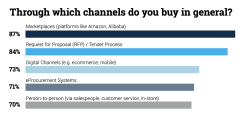Commerce trends 2022: A Focus on Digital Operations

To live up to customer expectations, businesses need to step up their game. They need to make sure they have the right technologies in place. That’s why in 2022, commerce businesses will be focussing on their technology stacks, to offer experiences that best meet the customer’s changing needs.
Let’s take a look at the most important commerce trends for 2022.
Automation and consolidation
In light of recent global events, eCommerce has become the main source of income for many industries. But eCommerce isn’t new. Many companies have been operating in the online B2C and/or B2B market for years.
Although companies have a great deal of experience, they must continue to evolve to retain customers. After all, customer expectations are changing. They want an easy order process, receive products faster, have easy returns policies, get personal customer service, and so on.
Replacing Legacy Systems
To meet these needs, keeping the sales software up-to-date is crucial. Many companies have purchased a series of technologies over the years to meet customer needs. To give a few examples: webshop platforms, a PIM for product information, a CRM for customer service, a WMS for the fulfillment, an ERP for inventory and accounting, and so on. And this is starting to cause problems.
Because these systems are often outdated, they are harder to maintain and unable to support modern back-office operations. As a result, they can’t meet new customer demands.
Therefore many companies will take a critical look at their eCommerce technologies in 2022. Questions about the technology stack will be raised: “What new technologies are on the market?”, “How can our services be made more efficient?”, “Do we still need all the software we use?”, And how do we handle our back-office operations in a smarter way?”, are just a few examples.

From a dispersed commerce system to a unified solution.
Consolidating commerce with a DOP
Decentralized, outdated, software is a frustration for many businesses. Switching between interfaces and transferring data manually results in inefficiency and a high chance of manual errors. A Digital Operations Platform gives your teams one central place to handle all data streams from multiple operational sources. It allows them to do their jobs the best way possible and work together in a single system.
More information:
Omnichannel: New Sales Channels
Omnichannel continues to grow. Customers are using more and more channels to make their purchases such as stores, webshops, marketplaces, and social media. Especially the last two have grown in the past year. Voice shopping also seems to be gaining momentum. Commerce entrepreneurs will no longer be able to ignore it in 2022: selling on different channels is necessary to reach customers and to stay ahead of the competition.
Social Commerce
Social media platforms have a billion-dollar audience worldwide. Many platforms are adding options to facilitate social commerce, allowing their users to purchase products within the app they are using.
In 2020, Instagram launched the Shopping tab as a way to discover new products. Facebook is also encouraging retailers to use its built-in storefront. The parent company of both apps, Meta, already sold in-app products to 88 million users in the US in 2021.

In addition, “live shopping” is a social commerce trend for 2022. Platforms like Instagram and Facebook already have their own live streaming functions. During live streams, products are presented, which can be purchased directly.
Voice Shopping
Whether at home, in the office, or on the go, “voice-enabled gadgets” are gaining popularity for shopping. Voice-enabled AIs, such as Apple’s Siri, Amazon’s Alexa, and Google’s Assistant, are developing technologies to make it possible.
According to current statistics, the voice assistant market will grow to a value of about $4 billion by 2022. The number of voice shoppers is expected to increase by 55%. Voice shopping will be worth $40 billion in 2022. In commerce, “Voice” is becoming an important strategy. Products need to be able to be found on keywords and phrases that match voice search queries.
B2B: Marketplaces
In 2018 already, online marketplaces such as Amazon, eBay and Alibaba.com were calling the shots within the B2C retail sector. They accounted for over 50% of global retail online sales. By 2021, B2C marketplaces have become an integral part of the B2C eCommerce strategy.

For B2B buyers, marketplaces are the most important platform for buying products
As marketplaces have matured in the B2C market, B2B marketplaces will gain momentum in 2022. According to recent research, within five years, 75% of B2B purchases will be made through an online marketplace. Enough reason for B2B companies to get involved.
Managing and Adding Multiple Sales Channels
With Marello, you can manage any type of sales channel. Whether it’s an eCommerce platform, marketplace, social media platform, POS, or app. Marello’s flexible architecture allows you to easily add new channels, without disturbing your running operations.
More information:
Sustainability
Sustainability is becoming increasingly important to consumers. The commerce industry has a huge impact on the environment, from the raw materials used to production and transportation. Consumers want to be able to make sustainable choices, and companies in the commerce world can help them do so.
Taking fulfillment routes into account can hugely help reduce CO2 emissions. Some options for a sustainable fulfillment strategy are:
- Ship-from-store when the store is close to the customer
- Choosing the warehouse closest to the customer
- Shipping from a warehouse that has all items in stock
Optimal order routing
Whether you’re shipping from one or more of your own warehouses or from your store locations, Marello’s order fulfillment system automatically routes your orders based on your preferred business rules. WFA Rules (Warehouse Fulfillment Allocation) are business rules that can determine the optimal sourcing and order fulfillment route. WFA Rules offer a flexible way to assign shipments to warehouses and create the most efficient and sustainable way to fulfill orders.

More information:
Subscriptions
Subscriptions have gained popularity in recent years. In the past three years, the number of visitors to subscription service sites has increased by as much as 3000%. Its growth is not yet at its maximum, getting even bigger in 2022.
But what exactly is an eCommerce subscription? In a nutshell, it is an offer of products or services, and collection of recurring payments, at a fixed frequency. These subscriptions can cover many different product categories: streaming services, food, hobbies, and everything in between.

And that brings benefits to the retailer, for example:
- A guaranteed number of sales per month
- Inventory and logistics are easier to plan and manage
- A higher customer value
Managing Subscriptions
Marello’s Subscription Management enables you to manage all your subscriptions operations in a unified application.
More information:
- Features: Subscription Management
- Case Study Subscription Management
- Subscription Management Whitepaper
Commerce trends 2022
The trends for 2022 are all important to providing a good customer experience. By providing customers with the best possible service, your 2022 commerce strategy will be stronger than ever.
Want to know how a DOP could help your business move forward in 2022? We’d love to help you out, send us a message and we’ll be in touch.
Back to blog